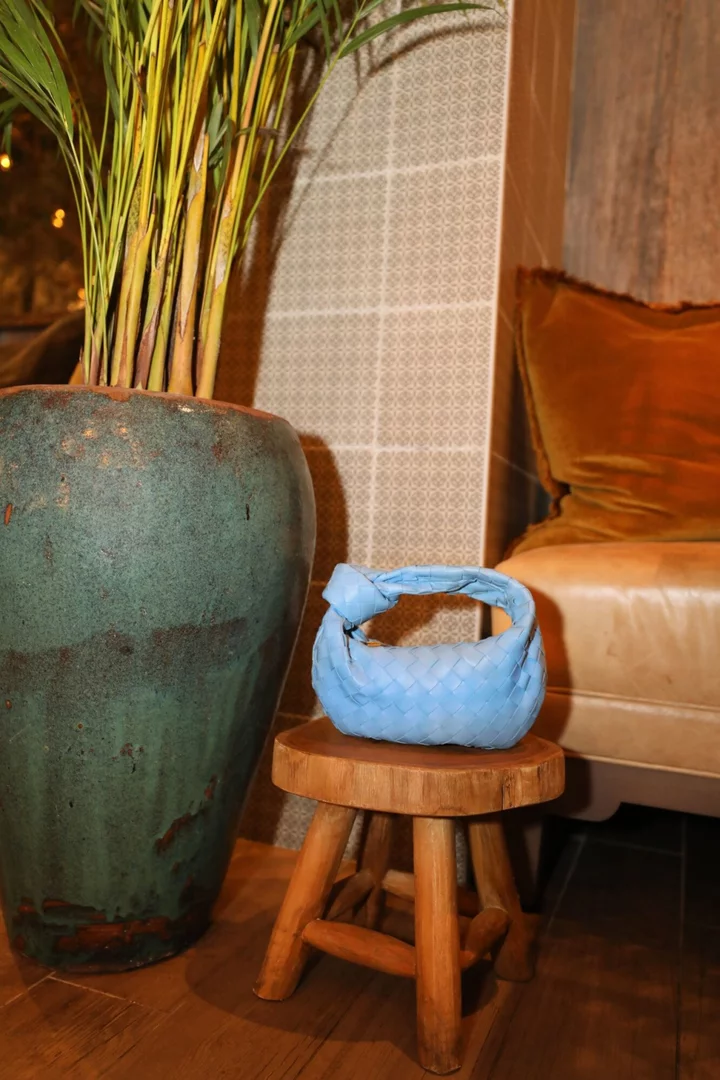In the opening episode of Season 2 of And Just Like That …, there’s a scene stealer, and it’s not a dress or a celebrity: It’s a purse stool. “Oh, thank you, my bag was exhausted,” says Sarah Jessica Parker’s Carrie, setting her Chanel purse down on the little white stool that’s pulled up to the fancy restaurant table. The miniature seats also add comic relief in Emily in Paris: The show’s star mistakenly sits on the little stand meant for her handbag at a Provence dining spot, revealing her naiveté.
Fine diners will recognize the purse stool as a familiar sight in high-end dining rooms. They are the kind of amenity you see in three Michelin-star French spots, where an army of waiters escort a woman to the bathroom and there are several courses of amuse-bouche—or starters—before a meal actually starts.
Now, however, those opulent emblems are taking up real estate in more casual-dining rooms, from brasseries in Miami to steakhouses in Boston.
Part of the reason is simple: More people have fancy purses that they don’t want sullied by the ground. Luxury purses, new and vintage, are in high demand. Sales of fashion and leather goods at luxury group LVMH—home of Louis Vuitton and Christian Dior—rose 18% in the first quarter of 2023 compared to the same period in 2022; the personal global luxury goods market grew by 22% in 2022 from 2021, to €353 billion ($384 billion), according to Bain & Co.
Besides the practical benefits of such stools, cultural superstitions from South America to Russia have added to the call for companion seats: In those countries, putting a bag on the floor is bad luck; it means you’ll lose money.
And purses have gotten used to being taken off the ground. As the rise in counter dining has proliferated, so have the hooks that diners can hang bags on. There’s also the question of safety: A clutch that’s within your line of sight is safer than one on the back of your chair.
These purse rests go beyond stools; they can take many forms, from a mini coat rack to a basket.
Among the dining spots you might not always have expected to find purse furniture is Rare Steakhouse at the Encore Boston Harbor resort in the Massachusetts capital. The menu is stocked with prime beef plus comfort food staples such as fully loaded baked potatoes, mac and cheese and Bailey’s cheesecake for dessert. The restaurant also provides little white upholstered chairs, which match the decor.
Even at fancy dining spots, the purse stool is proliferating more than it used to. Jean-Georges at the Connaught in London, with a six-course menu that go for £135 ($171), stocks five purse stools to be shared amongst diners. At the more recently opened Riviera Restaurant, located in sister property the Maybourne Riviera in Roquebrune-Cap-Martin, France, there are 20 tan purse stools; Bryan O’Sullivan Studio, which designed the restaurant, made them to match the decor.
But coordinated purse stools are modest compared to the ones offered at some notable dining spots, where they can cost more than the bags that rest on top. Restaurant Le Dalí in Le Meurice in Paris stocks foldable perches made by Hermès. The caramel-colored Pippa stools retail for almost £9,700.
No place has embraced the purse stool quite like the Miami area. At Aba in Bal Harbour, the laid-back Middle Eastern mini chain from the Chicago-based hospitality group Lettuce Entertain You, where cold meze and kebabs dominate the menu, there are little wooden stools for bags. (The Austin and Chicago Aba outposts do not feel it’s necessary to stock purse stools.) At Shingo, the recently opened 14-seat omakase spot in Coral Gables, chef-owner Shingo Akikuni has hand-woven baskets for guests to put their clutches and purses in. “I’m happy to see these points of service becoming more of a trend,” he says. “Fine-dining-only service points have made their way into more mainstream restaurants as service, generally, has become elevated across the industry.”
Even Stephen Starr—who made New York’s Meatpacking District a destination for boisterous brasserie dining at Pastis—has adopted the purse stool lifestyle, at least in South Florida. Although the fancy accessory is not an amenity traditionally found in a hectic dining hall (aren’t they a tripping hazard for tray-laden waiters trying to navigate narrow corridors between tables?), he has installed little coatlike stands for bags at his three spots Miami spots: Le Zoo, Makoto and even, yes, the latest outpost of Pastis.
“A restaurant has to go beyond its food to draw in a guest, and paying attention to the details is where you can show an added level of hospitality.” Starr says. “We don’t want our guests to be distracted by small, yet important, details like where to hang their bag. By providing a place for your purse, we take that worry away for the rest of your time there.”

